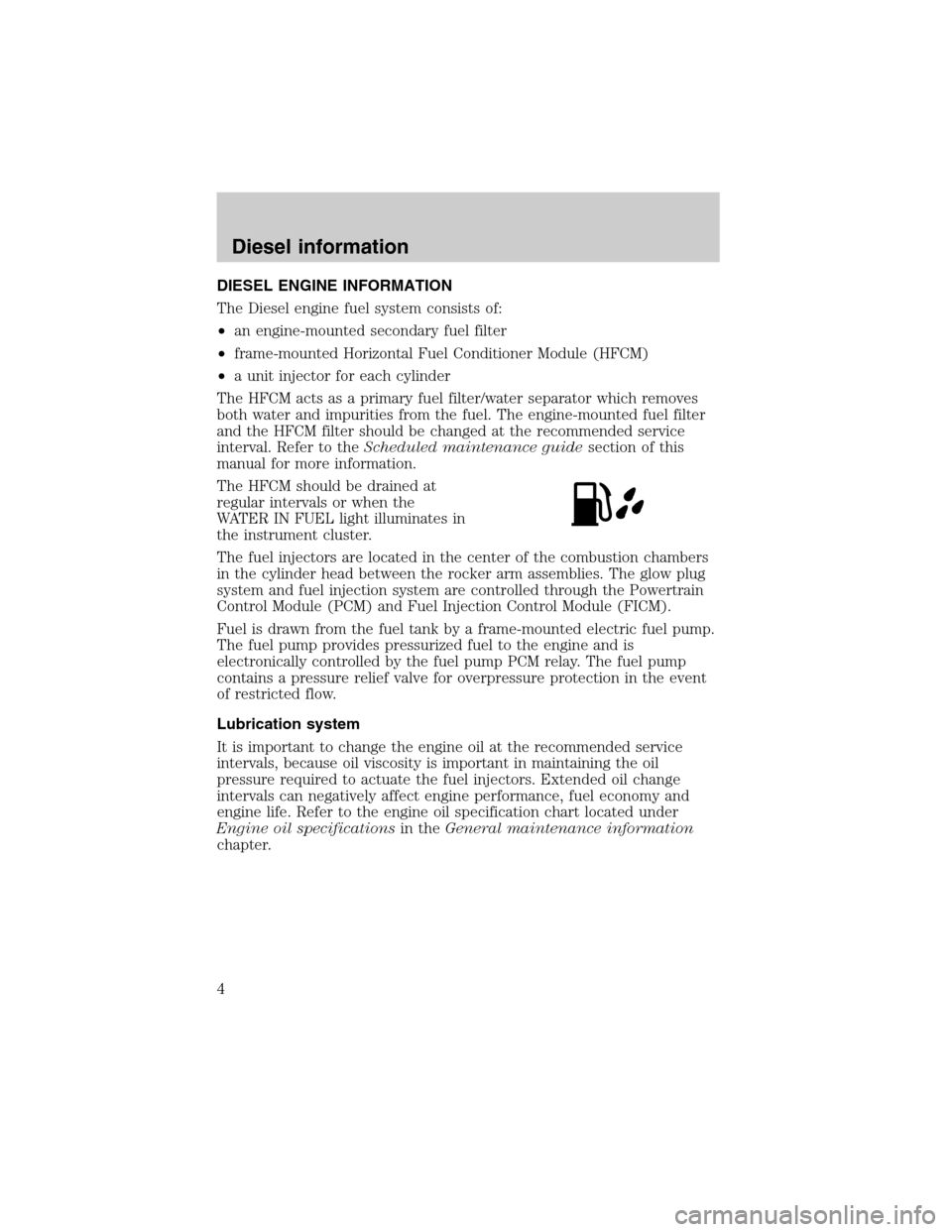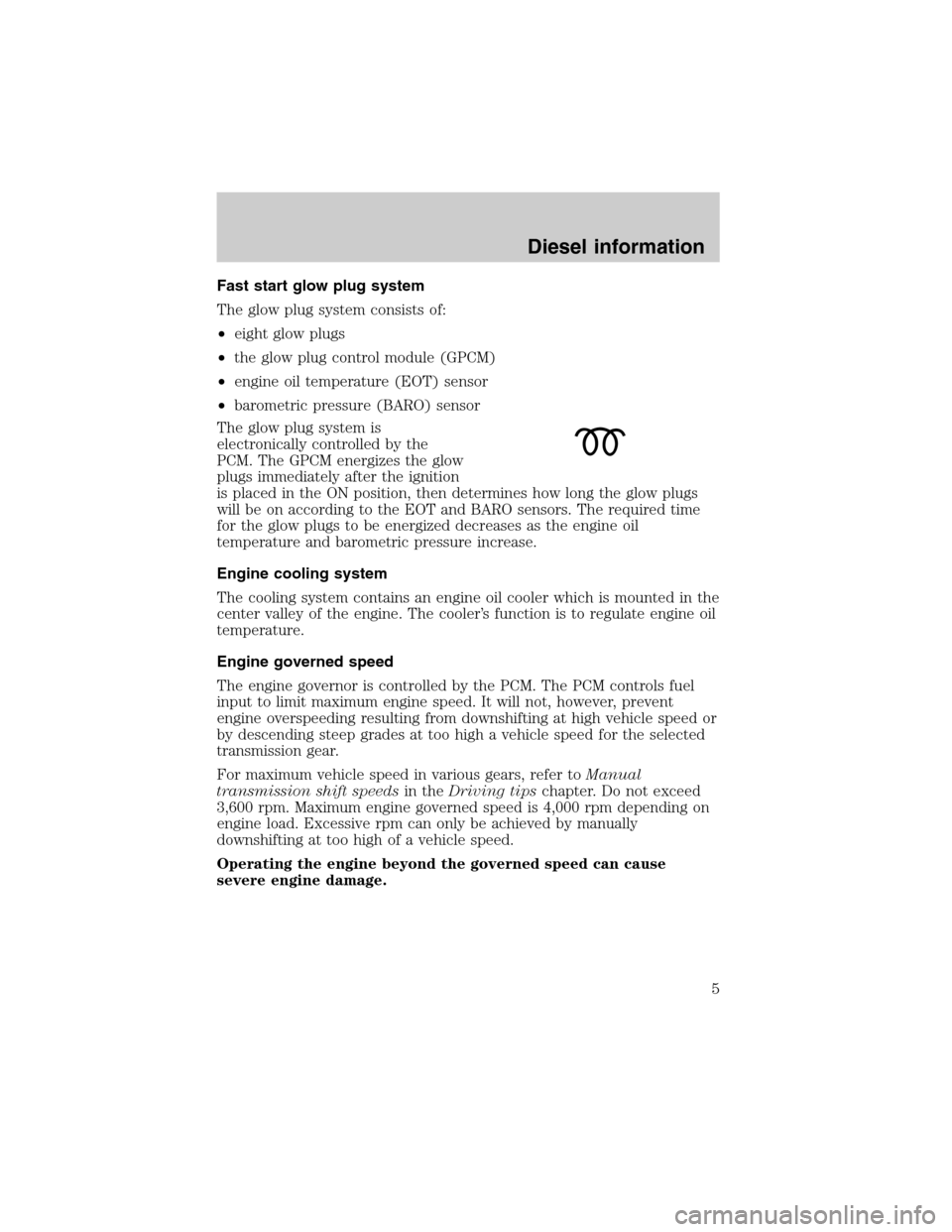Page 4 of 64

DIESEL ENGINE INFORMATION
The Diesel engine fuel system consists of:
•an engine-mounted secondary fuel filter
•frame-mounted Horizontal Fuel Conditioner Module (HFCM)
•a unit injector for each cylinder
The HFCM acts as a primary fuel filter/water separator which removes
both water and impurities from the fuel. The engine-mounted fuel filter
and the HFCM filter should be changed at the recommended service
interval. Refer to theScheduled maintenance guidesection of this
manual for more information.
The HFCM should be drained at
regular intervals or when the
WATER IN FUEL light illuminates in
the instrument cluster.
The fuel injectors are located in the center of the combustion chambers
in the cylinder head between the rocker arm assemblies. The glow plug
system and fuel injection system are controlled through the Powertrain
Control Module (PCM) and Fuel Injection Control Module (FICM).
Fuel is drawn from the fuel tank by a frame-mounted electric fuel pump.
The fuel pump provides pressurized fuel to the engine and is
electronically controlled by the fuel pump PCM relay. The fuel pump
contains a pressure relief valve for overpressure protection in the event
of restricted flow.
Lubrication system
It is important to change the engine oil at the recommended service
intervals, because oil viscosity is important in maintaining the oil
pressure required to actuate the fuel injectors. Extended oil change
intervals can negatively affect engine performance, fuel economy and
engine life. Refer to the engine oil specification chart located under
Engine oil specificationsin theGeneral maintenance information
chapter.
Diesel information
4
Page 5 of 64

Fast start glow plug system
The glow plug system consists of:
•eight glow plugs
•the glow plug control module (GPCM)
•engine oil temperature (EOT) sensor
•barometric pressure (BARO) sensor
The glow plug system is
electronically controlled by the
PCM. The GPCM energizes the glow
plugs immediately after the ignition
is placed in the ON position, then determines how long the glow plugs
will be on according to the EOT and BARO sensors. The required time
for the glow plugs to be energized decreases as the engine oil
temperature and barometric pressure increase.
Engine cooling system
The cooling system contains an engine oil cooler which is mounted in the
center valley of the engine. The cooler’s function is to regulate engine oil
temperature.
Engine governed speed
The engine governor is controlled by the PCM. The PCM controls fuel
input to limit maximum engine speed. It will not, however, prevent
engine overspeeding resulting from downshifting at high vehicle speed or
by descending steep grades at too high a vehicle speed for the selected
transmission gear.
For maximum vehicle speed in various gears, refer toManual
transmission shift speedsin theDriving tipschapter. Do not exceed
3,600 rpm. Maximum engine governed speed is 4,000 rpm depending on
engine load. Excessive rpm can only be achieved by manually
downshifting at too high of a vehicle speed.
Operating the engine beyond the governed speed can cause
severe engine damage.
Diesel information
5
Page 11 of 64

5. After the engine starts, allow it to idle for about 15 seconds. (Do not
increase engine speed until the oil pressure gauge indicates normal
pressure.)
STOPPING THE ENGINE
Turn the ignition to OFF. To prolong engine life (after extended high
speed or maximum GVW operation), it is recommended that a hot engine
be allowed to operate at low idle for about 7–10 minutes which would
allow sufficient time for the turbocharged engine to cool down.
COLD WEATHER OPERATION
Changing to a lighter grade engine oil also makes starting easier under
these conditions. Refer toEngine oil specificationsin theGeneral
maintenance informationchapter.
At temperatures below–7°C (20°F), Number 2–D Diesel fuel may
thicken enough to clog the fuel filter. Your vehicle is equipped with an
HFCM which acts as a fuel filter/heater/water separator to keep the wax
melted which will help prevent fuel filter clogging. However, if the engine
starts but stalls after a short time and will not restart, the fuel filter(s)
may be clogged. For best results in cold weather, use Number 1–D Diesel
fuel or“winterized”Number 2–D Diesel fuel which has an additive to
minimize wax formation.
Your vehicle is also equipped with a bypass relief valve, located on the
fuel control module, which provides fuel flow to the engine if the fuel
pickup should become plugged by ice or wax. To allow this bypass valve
to function and avoid engine fuel starvation, it is recommended that,
during cold weather operation 0°C (32°F) or below, the fuel level in your
tank should not be allowed to drop below 1/4 full. This will help prevent
air from entering the fuel system and stalling the engine.
In cold weather below 0°C (32°F) your Diesel engine will slowly increase
to a higher idle speed if left idling in P (Park). As the engine warms-up,
the engine sound level will decrease due to the activation of
PCM-controlled sound reduction features.
Operation in snow
Vehicle operation in heavy snowfall or in dry loose snow that may swirl
around the front of the vehicle may feed excessive amounts of snow into
the air intake system. This could plug the air cleaner with snow and
cause the engine to stall.
Refer toAir filter restriction gaugein theDiesel informationchapter
and Engine air filter in theWarning lightschapter for more information.
Starting
11
Page 49 of 64

Any adverse condition should be brought to the attention of your dealer
or qualified service technician as soon as possible for the proper service
advice. The owner maintenance service checks are generally not covered
by warranties so you may be charged for labor, parts or lubricants used.
Maximum Oil Change Interval:
Normal Schedule: 7,500 miles or 6 months, whichever occurs first.
Special Operating Conditions: 5,000 miles or 6 months, see appropriate
schedule.
Check every month:
•Check function of all interior and exterior lights
•Check tires for wear and proper air pressure
•Check engine oil fluid level
•Check windshield washer solvent fluid level
•Check and drain fuel filter/water separator
Check every six months:
•Check lap/shoulder belts and seat latches for wear and function
•Check air pressure in spare tire
•Check that externally-mounted spare tire is tight (see Owner’s Guide)
•Check power steering fluid level
•Check washer spray, wiper operation and clean all wiper blades
•Check parking brake for proper operation
•Check and lubricate all hinges, latches and outside locks
•Check and lubricate door rubber weatherstrips
•Check and clean body and door drain holes
•Check safety warning lamps (brake, ABS, air bag, safety belt) for
operation
•Check cooling system fluid level and coolant strength
•Check battery connections and clean if necessary
•Check clutch fluid level, if equipped
General Owner’s Information
49